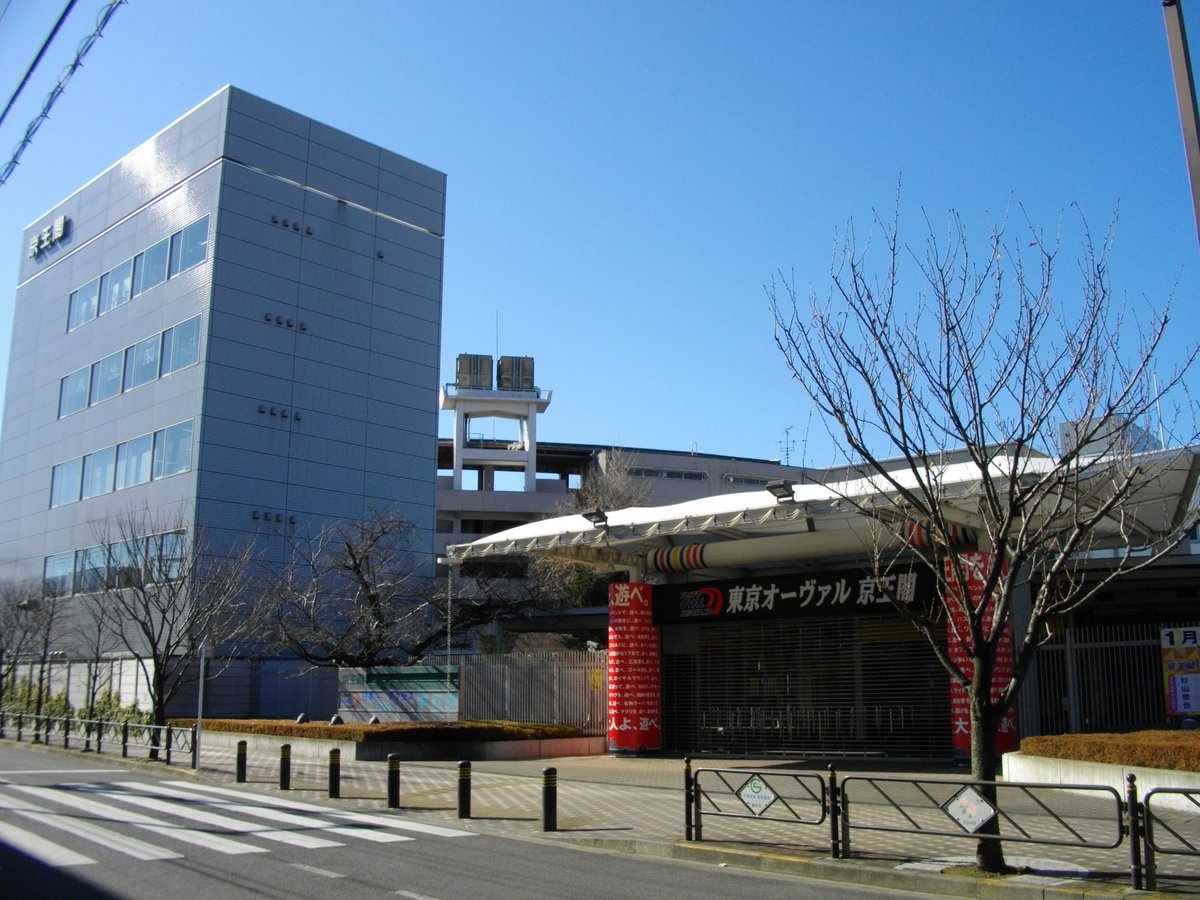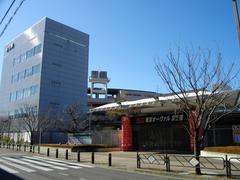
Keiokaku Velodrome Visiting Hours, Tickets, and Guide to Tokyo Historical Sites
Date: 14/06/2025
Introduction to Keiokaku Velodrome
Keiokaku Velodrome, officially known as Tokyo Oval Keiokaku (東京オーヴァル京王閣), is a premier cycling venue nestled in Chofu, a western suburb of Tokyo. Since its establishment in 1949, it has been a central figure in Japan’s keirin racing culture—a unique form of track cycling that merges high-speed competition with legal betting. The velodrome’s 400-meter oval track, modern spectator facilities, and vibrant event calendar make it a top destination for sports fans, cultural explorers, and families.
This detailed guide covers everything you need to plan your visit: from Keiokaku Velodrome visiting hours and tickets to accessibility, facilities, nearby attractions, and tips for an unforgettable experience. For official schedules and the latest updates, refer to the Keiokaku Velodrome website and event schedule.
Table of Contents
- Introduction
- History and Cultural Significance
- Track and Venue Features
- Visiting Hours and Ticketing
- Keirin Racing: Sport and Culture
- The Betting Experience
- Spectator Experience and Facilities
- Getting There: Access and Transportation
- Nearby Attractions and Local Highlights
- Practical Tips and Visitor Information
- Frequently Asked Questions (FAQ)
- Conclusion and Planning Resources
- References
History and Cultural Significance
Keiokaku Velodrome was established in 1949 during Japan’s post-war era, reflecting the nation’s embrace of modernization and the growing popularity of cycling as both a sport and leisure activity. Keirin racing, introduced in 1948 as a government-regulated betting sport, quickly became a mainstay of Japanese sporting culture. The velodrome has since evolved, hosting major competitions and community events, and serving as a living testament to Tokyo’s sporting heritage (Keiokaku Velodrome Visiting Hours, Tickets, and Tokyo Historical Sites Guide).
Keirin is not just a sport but a cultural institution in Japan, known for its strict training regimen, tactical races, and economic importance through legal betting. Riders undergo intensive training at the Japan Keirin School before qualifying to race professionally. The sport’s enduring presence in media, local festivals, and even manga reflects its deep roots in Japanese society (Pleasure in Japan).
Track and Venue Features
Track Specifications
- Length: 400 meters (standard keirin track)
- Incline: Up to 32 degrees
- Race Distance: Standard keirin races cover 2,025 meters (five laps)
Venue Layout
- Main Stand: General admission and reserved seating options with excellent views of the start/finish line
- West Stand: Additional seating and track perspectives
- Backstretch Stand: Alternative vantage points across the track
- East Stand: Under construction as of 2025 to increase capacity
- Screens and Stages: Large screens show live races; event stages host entertainment during major occasions
Facilities and Amenities
- Dining: Restaurants, cafés, and food stalls with Japanese and international options
- Museum of Keirin: Exhibits on the sport’s history, legendary riders, and vintage bicycles
- Beginner Guidance Corner: Staff assist newcomers with racing and betting basics
- Kids’ Room and Family Areas: Dedicated spaces for children and families
- Accessibility: Ramps, elevators, accessible restrooms, and multilingual signage
- Wi-Fi and Lockers: Free internet in public areas and coin-operated lockers for security
Visiting Hours and Ticketing
Visiting Hours
- Race Days:
- Day Races: 9:30 AM – 4:50 PM
- Night Races: 2:00 PM – 8:50 PM
- Off-Race Days: Limited public access; check the official schedule for details
Tickets and Admission
- General Admission: Typically ¥50–¥100, granting access to ground-floor benches
- Reserved Seating: Second and third floors, additional fee required; early purchase recommended for major events
- VIP Lounge: Premium fourth-floor area with exclusive amenities
- Special Events: Night races and festivals may have unique ticketing and entertainment options
Tickets are available at the venue on race days. Some events and seating tiers can be booked online via the official website.
Keirin Racing: Sport and Culture
Keirin is a tactical, high-speed form of track cycling, recognized as an Olympic sport and a symbol of Japanese sporting discipline. Races feature nine cyclists paced by a derny motorcycle before a final sprint, reaching speeds over 60 km/h. Strict rules govern equipment and conduct, ensuring fairness and safety (My Sports Tourist).
The sport is one of only four in Japan where betting is legal, making it a significant economic contributor. Keirin’s widespread appeal is fueled by its accessibility, daily races, and the communal excitement of wagering (Pleasure in Japan).
The Betting Experience
Betting is central to the keirin experience at Keiokaku Velodrome. Visitors can choose from a variety of wager types (win, place, quinella, trifecta, etc.) at automated machines or manned counters, with minimum bets starting at ¥100. Payouts are immediate following each race.
- Atmosphere: The betting halls are lively and welcoming, with regulars and newcomers analyzing odds and sharing tips.
- Language: Some machines offer English instructions; translation apps are recommended for deeper engagement.
Spectator Experience and Facilities
Atmosphere
Keiokaku Velodrome exudes an authentic, communal energy. The crowd is diverse, from seasoned fans to families and tourists. Between races, visitors enjoy the festive environment, sampling food, socializing, and exploring exhibits.
Seating and Viewing Tips
- Main Stand: Ideal for start/finish line action
- Backstretch Stand: Offers unique photo opportunities
- Premium Seating: Book early for major events
Practical Tips
- Arrive early, especially on weekends or special race days
- Bring cash for tickets, food, and betting
- Dress for weather; the stadium is open-air
- Photography is generally allowed, but check for restrictions on flash or professional equipment
Getting There: Access and Transportation
By Train
- Keio Line: 5-minute walk from Keio Tamagawa Station; on race days, a special exit reduces the walk to 1 minute
- JR Nambu Line: Free shuttle bus from JR Yanokuchi Station every 15 minutes on race days
By Bus or Taxi
- Local buses run from major stations; taxis are readily available, with fares typically under ¥1,000
By Bicycle
- The Tama River cycling path is nearby, with rental shops around Fuchu and Chofu
Accessibility
- All transport options and the venue itself are equipped for visitors with disabilities
Nearby Attractions and Local Highlights
Enhance your visit by exploring nearby Tokyo historical and cultural sites:
- Jindai Botanical Gardens: Beautiful seasonal blooms and peaceful gardens
- Fuda Daishi Temple: Historic Buddhist temple
- Chofu City Museum: Regional history and cultural exhibits
- Fuchu-no-Mori Park: Urban park with gardens and Fuchu Art Museum
- Okunitama Shrine: Ancient Shinto shrine, home to the Kurayami Matsuri
Dining and shopping opportunities abound in the Fuchu and Chofu station areas, offering both traditional and modern Japanese experiences.
Practical Tips and Visitor Information
- IC Cards: Use Suica or Pasmo for seamless travel on trains, buses, and in shops
- Language: Most signage is in Japanese, but English guidance is improving; translation apps are useful
- Seasonal Advice: June is rainy season—bring an umbrella or raincoat
- Family-Friendly: The venue has a kids’ room and is suitable for visitors of all ages
Frequently Asked Questions (FAQ)
Q: What are the visiting hours for Keiokaku Velodrome?
A: Day races run 9:30 AM–4:50 PM, night races 2:00 PM–8:50 PM; check the official schedule for updates.
Q: How much do tickets cost?
A: General admission starts at ¥50–¥100; reserved and VIP seats cost extra.
Q: Is the velodrome accessible for people with disabilities?
A: Yes, it features ramps, elevators, accessible restrooms, and multilingual signage.
Q: Can I buy tickets online?
A: Reserved and event tickets may be available online via the official website.
Q: Are guided tours available?
A: No regular tours, but the Beginner Guidance Corner provides assistance to new visitors.
Q: What nearby attractions should I visit?
A: Jindai Botanical Gardens, Fuda Daishi Temple, Okunitama Shrine, and more.
Conclusion and Planning Resources
Keiokaku Velodrome is a vibrant hub of sporting excitement, cultural tradition, and community spirit. Its accessible facilities, rich history, and lively atmosphere make it a must-see destination for both dedicated cycling fans and casual visitors. With convenient transportation, affordable tickets, and a wealth of nearby attractions, it’s an excellent way to experience an authentic slice of Tokyo.
Plan your visit:
- Check the official website for schedules, ticket information, and event updates.
- Download the Audiala app for interactive guides, live updates, and exclusive content.
- Explore nearby historical and cultural highlights for a full Tokyo experience.
References and Related Resources
- Keiokaku Velodrome Visiting Hours, Tickets, and Tokyo Historical Sites Guide
- Keirin Racing at Keiokaku Velodrome: Visiting Hours, Tickets, and Spectator Guide
- Keiokaku Velodrome Visiting Hours, Tickets, and Complete Guide to Tokyo’s Premier Cycling Venue
- Keiokaku Velodrome: Visiting Hours, Tickets, Access, and Nearby Attractions in Tokyo
- Keirin Racing in Japan: An Interesting Watch






























































































































































































































